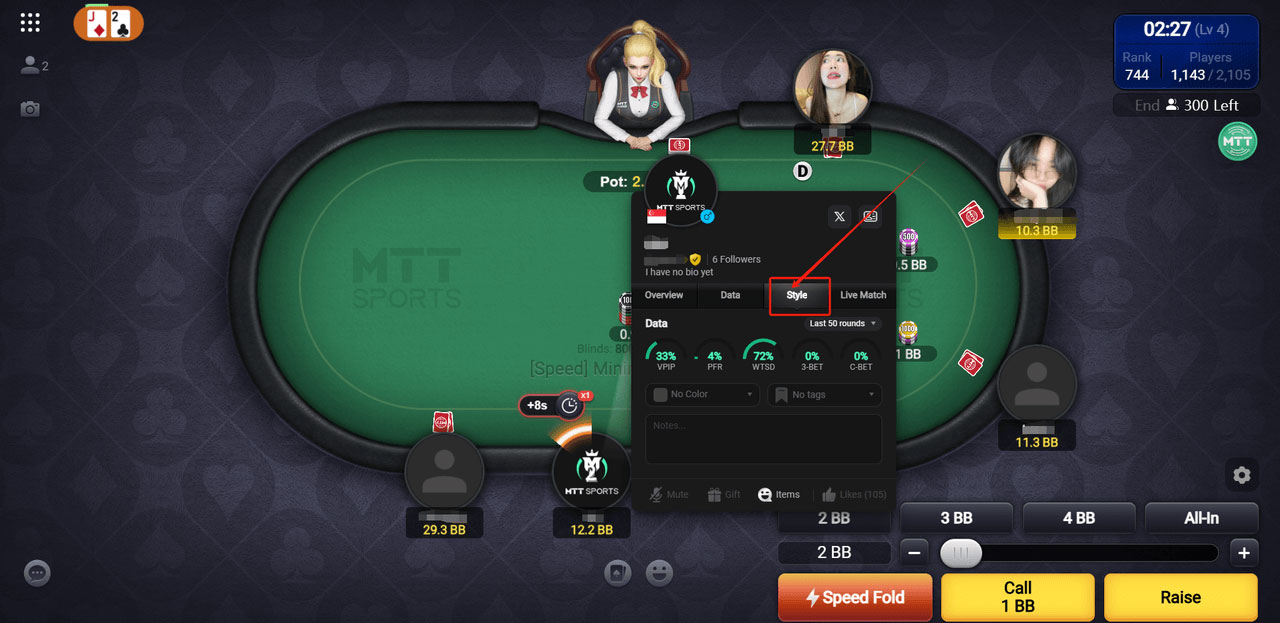Assisted decision-making function upgraded
Texas Hold'em Poker is an intellectual sport that involves obtaining information, making comprehensive judgments, and formulating strategies to maximize profits. In the same game, the more information a player obtains, the more reasonable his decision-making will be, and the winning rate will be higher in the long run.
Previously, MTT Sports explained the two functions of color and label in personal information cards.
Recently, MTT Sports has optimized the interaction style of [Personal Information Card]. In this optimization, [Personal Information Card] will be able to provide players with more reference information.
Now, during a game, players can view their opponent's [Personal Information] page by clicking on their opponent's avatar. This page displays four types of data: the opponent's achievements, statistics, style and match situation.
It is particularly worth mentioning that in the game, the information provided by the [Style] column is quite important.
The [Style] column will provide five different dimensions of statistical indicators of opponents in past games. Through these data, players can understand the opponent's playing style and style, and ultimately assist in decision-making based on the situation.
These five statistical indicators include: VPIP, PFR, WTSD, 3-BET and C-BET.
VPIP(Voluntarily Put In Pot)
Definition: How often a player proactively puts in chips before the flop, excluding forced big blind or small blind bets. VPIP can reflect the player's tightness.
For example, let's say a player plays 10 hands at a particular poker table. If you call or raise preflop in 4 of the hands and fold in the other 6, your VPIP will be 40%
- Tight-weak players: VPIP is less than 30%. These players are cautious and once involved in a hand, the quality is usually high.
- Loose players: VPIP exceeds 80%. This type of player does not care about winning or losing, likes to participate in the pot frequently, and has a wide range of starting hands.

PFR (Preflop Raise)
Definition: The frequency with which players raise before the flop.
PFR is smaller than VPIP because VPIP includes all actions that actively enter the pool, while PFR only counts pre-flop actions of players adding to the pool row.
For example, if you raise 3 of your first 10 hands in a poker game, your PFR will be 30%.
PFR is smaller than VPIP because VPIP includes all actions that actively enter the pool, while PFR only counts pre-flop actions of players adding to the pool row.
WTSD(Went To Showdown)
Interpretation: This metric shows the percentage of players who persisted until showdown after seeing a flop. WTSD is a very important indicator that shows the probability of your opponent folding after the flop.
High WTSD: If a player has a high WTSD, it means that he often goes to showdown and rarely folds.
Against a player with a high WTSD, this may mean that you should bluff less often and be better at raising if you have a good hand to get the most bang for your buck.
Low WTSD: If a player has a low WTSD, it means that he rarely goes to showdown and usually folds after the flop.
Facing a low WTSD player, this may mean taking advantage of raising after the flop when you have a strong hand; also, when this opponent bets on the river, he usually has a strong hand.
3-BET
Someone raises before the flop, and then the player raises again is called 3-BET.
For example, if another player raises preflop and player A chooses to raise again, this behavior is called 3-BET.
3-BET requires players to make good use of their position, especially the button position (BTN). 3-BET in a bad position usually only has medium-strength hands, or speculative hands to call a 3-BET.
C-BET(Continuation Bet)
C-BET refers to the behavior of a player who raised before the flop and continues to bet after the flop. For example, if Player A chooses to raise 3BB before the flop, and chooses to raise again after the flop, this behavior is called C-Bet.
High C-BET Rate: If a player has a high C-BET rate (for example, over 70%), it means that he often continues to bet after the flop, perhaps to exert pressure, or perhaps because his hand strength is indeed strong.
Low C-BET Rate: If a player's C-BET rate is low (for example, less than 30%), it means that he is more cautious and will only bet after the flop when his hands are strong.

In an intense game, the decision-making time given to players is limited.
In [Personal Information Card - Style], below the five statistics, players can mark their opponents simply and quickly.
Especially the color marking feature. After marking, the opponent's portrait frame will display the corresponding color, making it more intuitive for players.

For example, Player A has a habit of marking loose-aggressive players in red. In the game, when player A has a good hand, he can use this information to catch the player who is trying to use the bluff to take the pot.
From MTT Sports Official News
